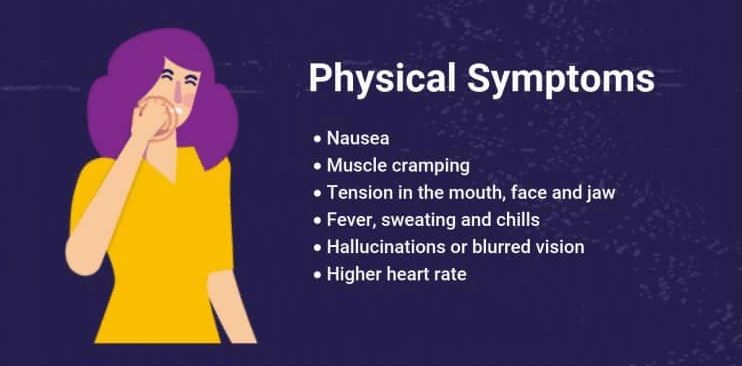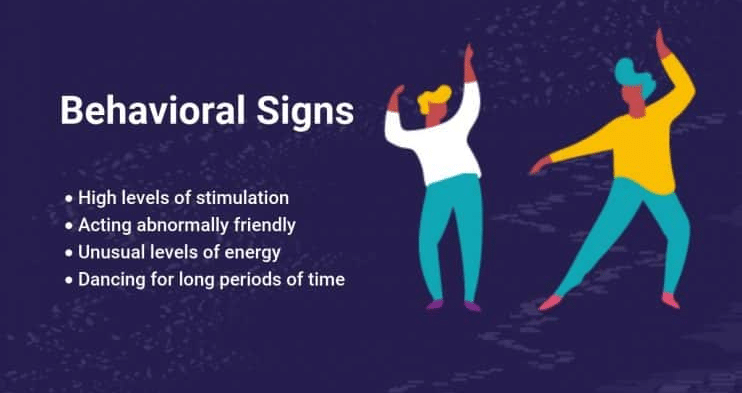Continuous Nausea Because of Mixing Mdma and Alcohol
Ecstasy (or MDMA) use can cause psychoactive effects, lower inhibitions and suppress fatigue and pain, but it can also lead to cognitive impairment and a deadly fever.
Molly (also known as MDMA or ecstasy) use can cause psychoactive effects, lower inhibitions, suppress fatigue, suppress pain and lead to cognitive impairment. MDMA can also cause nausea, muscle cramps, potentially deadly temperature spikes or cognitive impairment following chronic use.
People also seem to develop a tolerance for ecstasy fairly rapidly. Thus, with repeated abuse, it becomes difficult, if not impossible, for people to experience the same effects as the first time they took the drug. Here are the short-term and long-term signs, symptoms and side effects of using ecstasy recreationally.
Article at a Glance:
- Ecstasy's physical symptoms include nausea, fever, hallucinations, high heart rate and cramping.
- A person taking ecstasy may feel increased energy, great pleasure, heightened sexuality and euphoria.
- Ecstasy is not considered an addictive substance; however, people can become dependent on using it.
- It is common for someone to believe they are taking ecstasy when they are actually taking an unknown substance that is counterfeit ecstasy.
- Long-term effects of chronic ecstasy use include insomnia, memory loss, depression and fatigue.
How Long Does Molly Take To Kick In?
Molly begins working fairly quickly, in about 20–60 minutes. This time varies greatly from person-to-person, probably related to the inconsistent purity of the product when obtained illegally. Taking MDMA via snorting or other methods may shorten the time it takes to start working.
How Long Does Molly Last?
For most people, the peak effects will happen within two hours. The whole experience is usually four to six hours but varies greatly depending on how much is taken, whether it was mixed with other drugs and if someone continues taking more of it. Molly can also interact with some medications, prolonging its effects and increasing the risk of side effects.
What Does Molly (Ecstasy) Feel Like?
Shortly after taking the drug, the individual may experience a range of side effects due to the combination of the stimulant and hallucinogenic properties. Some desired effects of ecstasy can begin in as little as 30 minutes and last up to six hours. These can include:
- A perceived increase in energy levels
- Euphoric state of being
- Distorted perception of time
- Higher pleasure from physical touch
- Increased levels of sexuality and sexual arousal
- Increased energy and focus
- Feelings of emotional peace and empathy
Additional short-term side effects include the suppression of certain basic physical needs — for example, eating, drinking and sleeping — because of the stimulant effect of the substance. As a result, an individual on Molly may attend contemporary "rave" parties or dance and music festivals that can exceed 24 or even 48 hours in duration, all while focusing on loud, electronic music, flashing lights and extended periods of dancing to enhance the effects of the substance.
Common Signs of Molly (Ecstasy) Use
Ecstasy is often taken with other substances, which can alter the symptoms and make it difficult to spot signs of abuse. However, some key symptoms may make it easier to determine that someone is abusing the substance.
Changes in Activities:
- High levels of stimulation
- Unusual levels of energy
- Long hours awake
- Acting abnormally friendly
- Dancing for long periods of time
Changes in Reactions:
- Overly sensitive to music or lights
- Exaggerated pleasure from touch
- Pain is dulled
Changes in Physical Appearance:
- Nausea
- Chills
- Sweating
- Blurred vision
- Dilated pupils
- Muscle cramps
- Tight, clenched jaw
- Overheating
- Collapsing
When an individual becomes dependent on the drug, they may continue to frequently attend dance parties. They'll use the substance even though, in lucid moments when not on the drug, they may realize the damage they are doing.
Molly (Ecstasy) Side Effects
Ecstasy can have numerous undesirable side effects, including transient hypertension and problems with thermoregulation — resulting in elevated body temperature. When individuals begin to abuse ecstasy habitually, they can develop a tolerance to the substance, so they need larger doses to achieve the same level of effects.

Common Side Effects of Molly/Ecstasy/MDMA:
- Nausea
- Muscle cramping
- Fever
- Sweating and chills
- Shaking and tremors
- Hallucinations
- Blurred vision
- Higher heart rate
- Increased blood pressure
- Tension in the mouth, face and jaw
- Feeling faint
There are questions as to whether cognitive impairments are due to MDMA abuse alone or due to heavy substance abuse in general since many individuals who take these drugs also engage in other substance abuse. One study found that the persistent cognitive impairments seen in moderate MDMA abusers are no more severe than those seen in heavy substance abusers in general, but that multi-substance abuse in conjunction with MDMA might increase these risks.
Long-Term Side Effects of Molly (Ecstasy)
While research on the long-term effects of ecstasy abuse is ongoing, certain traits are shared by regular abusers. For example, a large review of studies regarding MDMA use in animals and humans found irreparable damage to transporters for the neurotransmitters serotonin and dopamine.
Researchers believe that the drug causes a flood of serotonin in the brain during usage, and its overproduction causes damage. Because serotonin levels affect learning, sleep and emotional processes, this damage can leave people with an ecstasy use disorder. Without proper functioning neurotransmitters, conditions like depression, anxiety, insomnia and memory loss are more likely to occur. These conditions can be present for long periods of time, even after ecstasy use ends.
Although MDMA is not generally considered an addictive substance, a report in Scientific American suggests that some people may become dependent on or addicted to the substance. Most people who abuse MDMA restrict their abuse to weekends because frequent misuse quickly reduces the positive effects as a tolerance to the substance develops.
Street drug dealers market MDMA as a safe, non-addictive recreational drug that enhances a person's enjoyment and ability to interact with others. Nothing could be further from the truth. Even the occasional light abusers risk overdose and premature death. Moderate to heavy abusers risk addiction, as well as long-term impairments in psychological and cognitive functioning.
Misusers of MDMA often lose their ability to relate to and enjoy being with other people without the influence of a mind-altering, dangerous substance, at least temporarily.
Behavioral Changes

Ecstasy abuse is commonly connected with having multiple sexual partners. People abusing the drug can feel they are deeply in love with the person they are involved with, even if they just met. These feelings often persist until the effect wears off.
Even if a person avoids death from overheating or overdosing, cravings can very quickly set in. These cravings can drive a person to use ecstasy continuously, even when they know it is harmful.
Other behavioral signs could include an irregular sleeping schedule and a lack of awareness of pain — for example, if a person gets injured but has no reaction or doesn't even realize it.
Effects of Molly on the Brain
MDMA is structurally similar to stimulants like methamphetamine and amphetamine. However, while other stimulants mostly impact dopamine in the brain, MDMA also affects serotonin and norepinephrine. By releasing more serotonin and norepinephrine than dopamine, Molly has major impacts on mood, appetite, pain and empathy-related behaviors.
Unlike most other illicit drugs, the effects of Molly seem to be long term. Animal studies have shown permanent neuron damage up to seven years later. After acute usage, serotonin transmitters, which move serotonin from one neuron to another, are less active for at least several weeks.
Even people who stop taking MDMA have permanent changes in their brains. It is unclear why ecstasy causes such permanent changes compared to other drugs. These effects are measured using positron emission tomography (PET scan) and include impacts on memory, mood, emotion processing and learning. It is not known if just a few uses cause these same effects.
Common Symptoms of (Molly) Ecstasy Use
Ecstasy stands out from other illicit substances for its ability to heighten feelings of empathy, love and sexual arousal in those who take it. People who abuse it report feeling love for everyone in the room and overwhelming joy. They also often experience distortions in the way time passes and may be delighted by their senses, enjoying bright colors and soft textures.
Long-Term (Molly) Ecstasy Symptoms
Some signs that someone is chronically abusing ecstasy include problems sleeping and insomnia, memory loss, anxiety, paranoia, lethargy or fatigue, and depression. They may also exhibit some of the general signs of substance abuse, which can include a decline in their physical health and outward appearance, nausea, sweating, coordination problems, changes in sleep and eating habits, laziness or lethargy, mood swings and secrecy.
Ecstasy abuse can change the brain's chemistry rapidly, affecting its ability to release and metabolize serotonin. These changes can result in memory impairment, anxiety, depression, confusion and poor short-term and long-term performance. Tests have shown that even brief exposure to ecstasy can result in damage that lasts years.
Many risks come with abusing ecstasy, including the risk of unknowingly taking a substance other than ecstasy, as well as short-term and long-term health conditions affecting the body's temperature regulation system and cardiovascular system. Individuals who take ecstasy may also participate in riskier and more dangerous behaviors than before. Possessing ecstasy is also a criminal offense, with legal and financial consequences awaiting the user.
If you recognize the symptoms of ecstasy use disorder in a loved one or even yourself, it's important to speak with a representative at The Recovery Village. Abusing Molly/MDMA/Ecstasy can lead to serious health effects, including death. You can seek professional and medical assistance at a detox and rehab treatment center like The Recovery Village.

Editor – Abby Doty
Abby Doty graduated from Hamline University in 2021 with a Bachelor's in English and Psychology. She has written and edited creative and literary work as well as academic pieces focused primarily on psychology and mental health. Read more

Medically Reviewed By – Dr. Conor Sheehy, PharmD, BCPS, CACP
Dr. Sheehy completed his BS in Molecular Biology at the University of Idaho and went on to complete his Doctor of Pharmacy (PharmD) at the University of Washington in Seattle. Read more
- Hanson, Karen & Luciana, Monica. "Neurocognitive impairments in MDMA and other drug users: MDMA alone may not be a cognitive risk factor.">Neurocog[…] risk factor. " Journal of Clinical and Experimental Neuropsychology, September 30, 2009. Accessed June 15, 2020.
- Vegting, Yosta; Reneman, Liesbeth; & Booij, Jan. "The effects of ecstasy on neurotransmitter systems: a review on the findings of molecular imaging studies.">The effe[…]ging studies. " Psychopharmacology, August 28, 2016. Accessed June 15, 2020.
- Merle Gordon, Susan. "What are the effects of the drug Ecstasy?">What are[…]drug Ecstasy? " Scientific American, July 5, 2001. Accessed June 15, 2020.
- National Institute on Drug Abuse. "MDMA (Ecstasy) Abuse Research Report What are MDMA's effects on the brain?">MDMA (Ec[…]on the brain? " April 9, 2020. Accessed June 15, 2020.
- National Institute on Drug Abuse. "MDMA (Ecstasy) Abuse Research Report What is MDMA?">MDMA (Ec[…]What is MDMA? " April 9, 2020. Accessed July 1, 2022.
- Wagner, Daniel, et al. "A prospective study of learning, memory, and executive function in new MDMA users.">A prospe[…]w MDMA users. " Society for the Study of Addiction, January 2013. Accessed June 15, 2020.
- Rodgers, J., et al. "Patterns of Drug Use and the Influence of Gender on Self-Reports of Memory Ability in Ecstasy Users: A Web-Based Study.">Patterns[…]-Based Study. " Journal of Psychopharmacology, December 1, 2003. Accessed June 15, 2020.
- National Institute on Drug Abuse (NIDA). "What are the effects of MDMA?"">"What […]s of MDMA?" September 2017. Accessed June 19, 2022.
- Bluelight.org. "Losing the Magic."">"Losin[…]the Magic." January 2011. Accessed June 19, 2022.
- Bluelight.org. "Can MDMA speed up feelings of love in a relationship?"">"Can M[…]ationship?" May 2010. Accessed July 1, 2022.
- Cohen, Isaac, et al. "Concomitant drugs associated with increased mortality for MDMA users reported in a drug safety surveillance database."">"Conco[…] database." March 2021. Accessed July 1, 2022.
- DrugScience. "MDMA (Ecstacy)."">"MDMA (Ecstacy)." Accessed July 1, 2022.
Medical Disclaimer
The Recovery Village aims to improve the quality of life for people struggling with substance use or mental health disorder with fact-based content about the nature of behavioral health conditions, treatment options and their related outcomes. We publish material that is researched, cited, edited and reviewed by licensed medical professionals. The information we provide is not intended to be a substitute for professional medical advice, diagnosis or treatment. It should not be used in place of the advice of your physician or other qualified healthcare providers.
wilbankscoperfell.blogspot.com
Source: https://www.therecoveryvillage.com/ecstasy-mdma-addiction/side-effects/
0 Response to "Continuous Nausea Because of Mixing Mdma and Alcohol"
Post a Comment